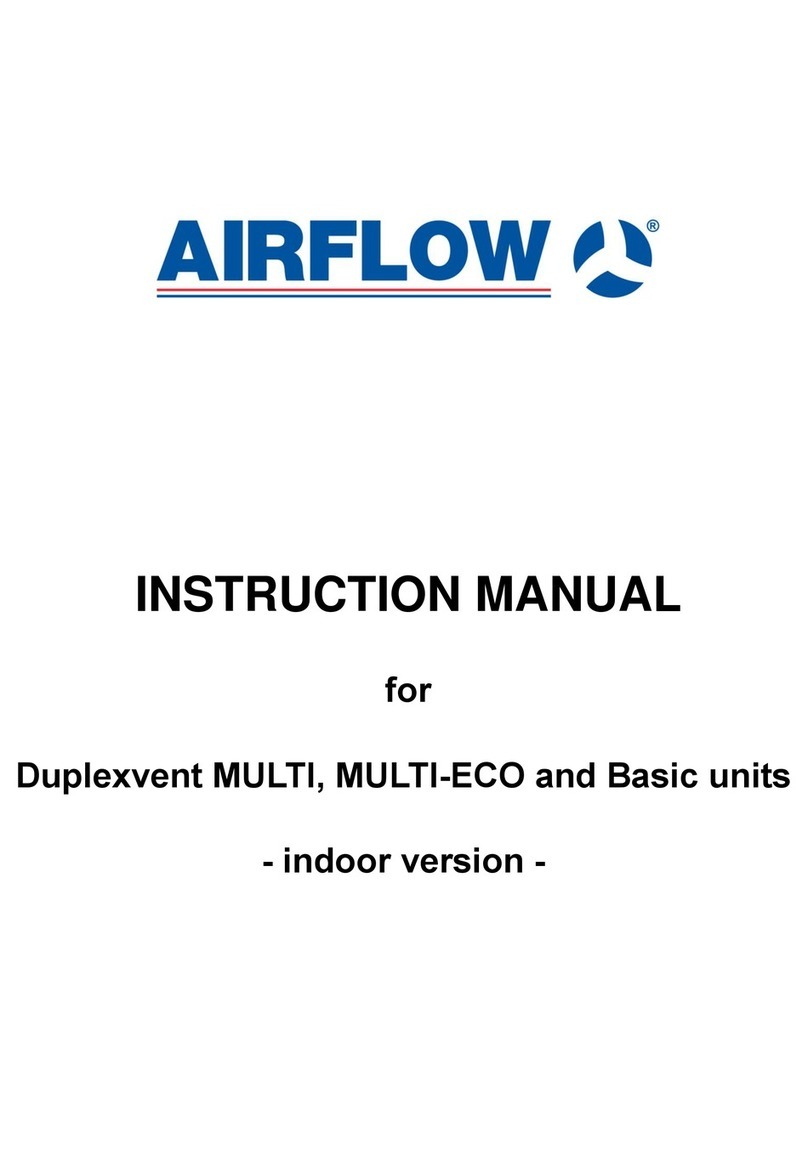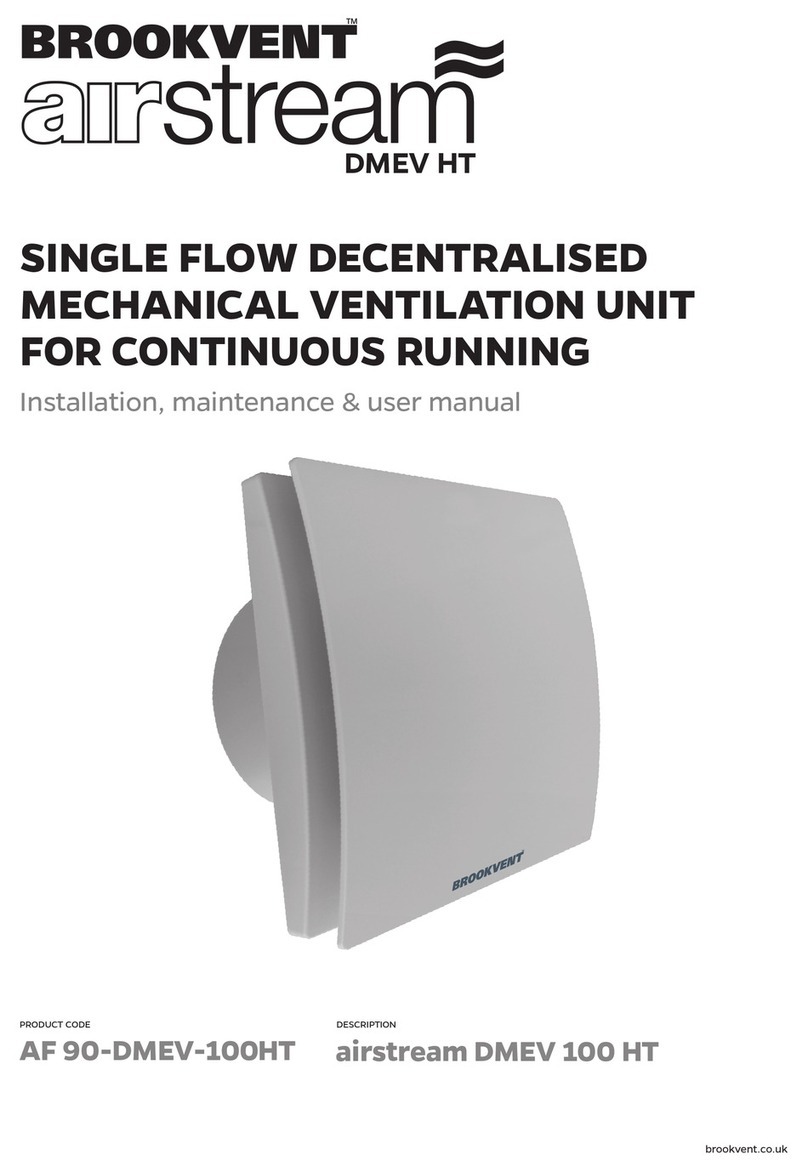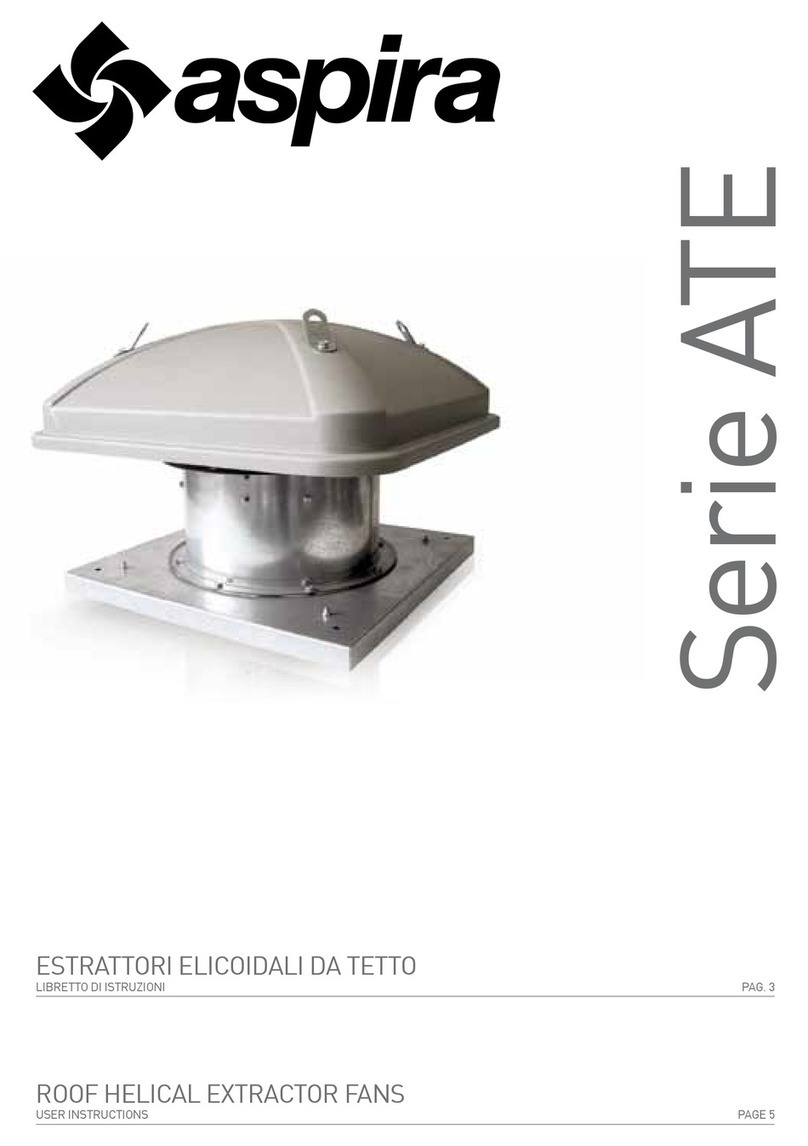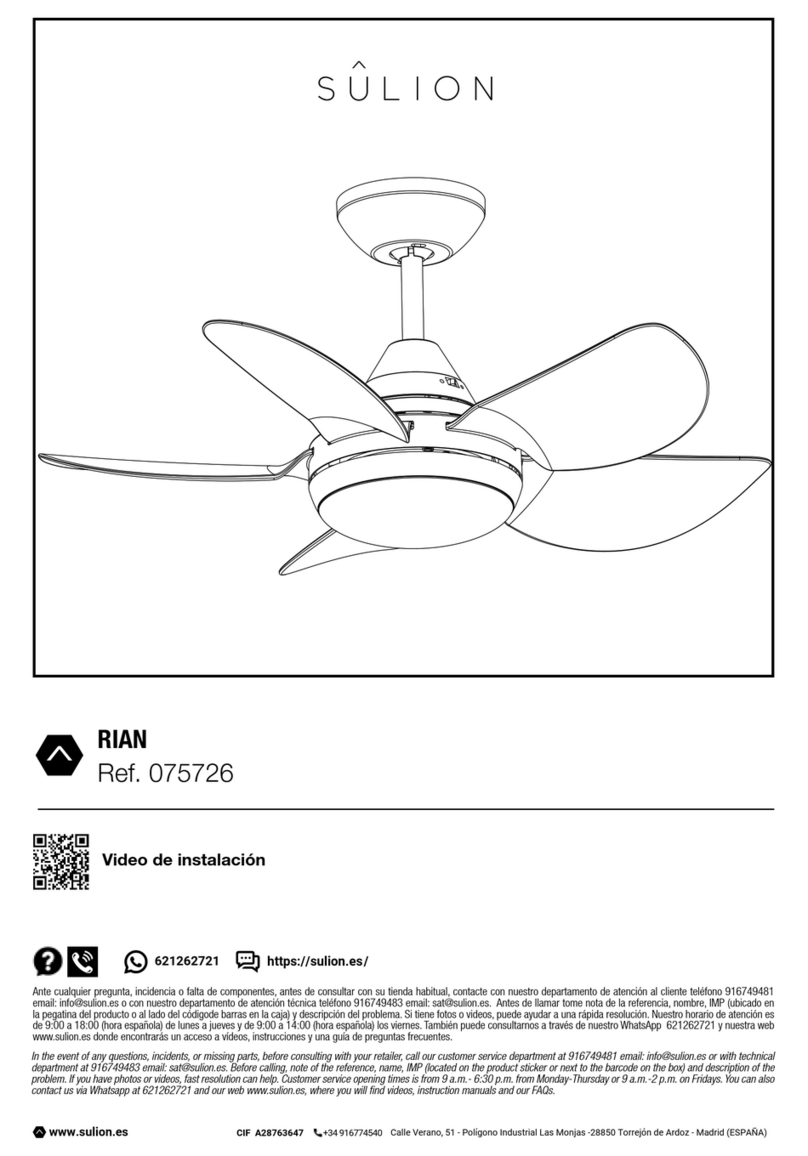Temspec VER1800 Manual

Operation & Maintenance Manual
VER Vertical Unit Ventilator
with Integral Energy Recovery
Form SC-OM-MANUAL ©2011 Temspec Incorporated
IMPORTANT: Read and save this manual for future reference.
This manual is to be left with the equipment owner

Operations & Maint.Manual VER Rev2.doc [1]
Table of Contents
INTRODUCTION
About the VER ...................................................................................................................2
Nomenclature for VER .......................................................................................................2
TYPICAL UNIT LAYOUT
Model VER 1800 (ducted)..................................................................................................3
OPERATION
Sequence of Operation ..................................................................................................... 4
Hot Water Circuit................................................................................................................5
Refrigeration Circuit............................................................................................................6
Electrical Circuit .................................................................................................................7
Dampers.............................................................................................................................7
Optional 100% Economizer................................................................................................7
Optional Powered Exhaust.................................................................................................7
Filtration .............................................................................................................................7
MAINTENANCE
Servicing the Unit...............................................................................................................8
Maintenance Schedule.......................................................................................................8
Changing the Filters...........................................................................................................9
Waterside Component Maintenance..................................................................................9
Cleaning the Evaporator Coil ...........................................................................................10
Motors..............................................................................................................................10
Cleaning the Energy Recovery Wheel..............................................................................10
TROUBLESHOOTING
Basic Troubleshooting Guidelines....................................................................................11
REPLACEMENT PARTS
Limited Warranty..............................................................................................................12
Part Sales.........................................................................................................................12

Operations & Maint.Manual VER Rev2.doc [2]
INTRODUCTION
The Temspec integrated energy recovery unit ventilator was designed as a means for
providing energy efficient heating, cooling and ventilation to the classroom. Our goal is to
help create an enhanced learning environment by focusing on the following points when
designing our equipment:
•TEMPERATURE & HUMIDITY CONTROL
•AIR DISTRIBUTION
•SOUND ATTENUATION
•ENERGY EFFICIENCY
By introducing the VER into the classroom, superior control can be obtained for each room.
Because of the unit’s ducting capabilities, an even distribution of air can be achieved
throughout the room. The VER is constructed with heavy gauge metal and sound
absorbing insulation for optimal sound attenuation.
By applying sound engineering principles and through continuous testing, the highest
quality of performance is obtained in the unit ventilator.
ABOUT THE ENERGY RECOVERY UNIT VENTILATOR
NOMENCLATURE FOR UNIT VENTILATORS INTEGRAL ENERGY RECOVERY
V
ER
Vertical Unit
ER = Energy Recovery
1800
1800 = Maximum Supply Air c.f.m.

Operations & Maint.Manual VER Rev2.doc [3]
TYPICAL LAYOUT
SA = Supply Air
VA = Ventilation Air
ECA = Economizer Air
RA = Return Air
EA = Exhaust Air
ITEM NO.
DESCRIPTION
ITEM NO.
DESCRIPTION
ITEM NO.
DESCRIPTION
1.
Evaporator Coil
8.
ERV Exhaust Filter
15.
Hot Water Coil
2.
Drain Pan
9.
Powered Exhaust Damper and Actuator
16.
Supply Air Fan
3.
100% Economizer OA Damper
10.
ERV O.A. Filter
17.
LH Hinged Access Panel
4.
Modulating damper actuator.
11.
RA Actuator
18.
Removable Access Panel
5.
ERV Damper with Actuator.
12.
RA Damper
19.
Heavy Duty RA Grille
6.
ERV Exhaust Fan
13.
Mixed Air Filters
7.
ERV Enthalpy Wheel
14.
Electrical Box/Controls Enclosure
NOTE: The component arrangement shown above may vary slightly from that in the unit supplied.
Models VER 1800 –HW / DX Split (ducted configuration)

Operations & Maint.Manual VER Rev2.doc [4]
OPERATION
The following is a control strategy table for a VER 1800 with integral ERW, powered exhaust and
W7212 Honeywell Economizer Module. The UV has one stage of DX cooling and modulating
hydronic heat.
NOTE: The Economizer, based on an increased requirement for cooling can modulate the Outdoor
Damper in full-open position. If the outdoor air temperature (measured by the mixed air sensor) drops to
45°F, the Economizer fully closes the damper to protect from freezing the hot or chilled water coils.
Control returns to normal once the mixed air temperature rises to 48°F.
Freeze Protection
For units with a steam or hot water coil, some type of freeze protection is usually
implemented. This can be either low limit temperature control (manual or auto reset) or by
using a supply air sensor and programming from the controller. When a mixed air temperature
is determined to be too low, the outdoor air damper will close, and the control valve will fully
open. In some cases, the fan will also shut down until the temperature returns to normal
levels.
Typical Modes of Operation

Operations & Maint.Manual VER Rev2.doc [5]
The following is a typical hot water piping schematic for the VER 1800. Please refer to the shop
drawings for a more specific layout.
Hot Water with 2-Way Control Valve
ITEM NO.
QTY
DESCRIPTION
ITEM NO.
QTY
DESCRIPTION
1.
1
Hot Water Coil
5.
1
Valve, 2-Way, Modulating
2.
1
Manual Air Vent
6.
1
Actuator - Modulating
3.
1
Drain Cock
4.
1
Ball Valve –Memory Stop
Warning: City water is very corrosive to brass Components. Provide water treatment as soon as
the system is charged to avoid premature leaks and/ or failure of internal components.
Hot Water Circuit

Operations & Maint.Manual VER Rev2.doc [6]
The following is a typical DX Split piping schematic. Please refer to the shop drawings for a more
specific layout.
ITEM NO.
QTY
DESCRIPTION
1.
1
Coil –DX –R410A
2.
1
Valve –Access –With Core –600psi
3.
1
Controller –Anti-Ice
4.
1
Valve –TX-R410A
5.
1
Distributor
6.
1
Nozzle –Size J2
DX Refrigeration Circuit

Operations & Maint.Manual VER Rev2.doc [7]
The electrical circuit in the VER 1800 is dependent on the controller and sequence that is
being utilized. The unit can be supplied with a 115V, 208V, 277V or 460V power supply.
The unit is equipped with an unfused service disconnect. A copy of the electrical schematic
can be found folded in a pouch inside of unit ventilator located on the electrical enclosure or
supply air fan housing.
All the outdoor air damper assemblies have airfoil section extruded aluminum blades with
flexible seal blade tips, jamb seals and spring return damper actuators. The damper
actuator manufacturer can vary. Please refer to the wiring schematic for the damper
actuator model type and control.
100% economizer is an option feature on the energy recovery unit ventilator. This module
includes a modulating spring return damper actuator and aluminum damper assembly and
associated controls.
Internal powered exhaust is an optional feature that may be provided with the VER series.
This feature comes with a spring return actuated aluminum damper, direct drive fan and
ECM motor. It shall operate in tandem with the economizer damper to be able to provide up
to 100 % power exhaust
Typically, 1” or 2” disposable filters are provided in the unit. Please refer to the “shop
drawings” for specific details on filter construction and thickness for your unit. Below are
the sizes and quantity for the typical base unit and additional filters for optional modules.
Location Filter Size Quantity per Unit
Mixed Air 20” x 25”nominal 2
Energy Recovery Module 12” x 20”nominal 2
Electrical Circuit
Dampers
100% Powered Exhaust (optional)
Filtration
100% Economizer (optional)

Operations & Maint.Manual VER Rev2.doc [8]
MAINTENANCE
Maintenance to the unit is accomplished by removing the front access panels. Typically,
the panels are secured by heavy duty Phillips (star or cross shape) head screws. When
removing the access panel, loosen but do not remove the screws. Carefully store the panel
in a place where it will not get damaged. Use caution as some access panels are heavy.
CAUTION: Disconnect power at the remote circuit breaker before servicing the
unit.
The unit comes fitted with a “fan kill switch” that de-energizes the supply air fan(s) when the
filter access panel is removed / opened. This will only disconnect the power to the supply
air fans. Be sure to disconnect ALL power by turning the remote circuit breaker to the off
position.
To access the ERV section, you must remove secondary panels located directly behind the
return air access panel.
Interior and exterior environmental conditions will influence the required frequency of coil
cleaning and filter change operations. The following is a typical maintenance schedule for
a classroom unit ventilator.
Initial Start-Up •Change out construction filters.
•Verify that air paths are free of construction debris and that fans turn
freely
•Verify dampers and ERV operation.
Every 3 months •Change filters
Every 6 months • Visually inspect the condition of ERV desiccant wheel, clean if
necessary.
Every 12 months •Vacuum out the cooling coil drain pan
•Clean strainer in the hydronic circuit (if applicable)
Every 24 months •Clean cooling coil
•Vacuum any loose debris from unit’s interior return air section
•Inspect dampers to ensure that there is a proper seal
Servicing the Unit
Maintenance Schedule

Operations & Maint.Manual VER Rev2.doc [9]
The outdoor and indoor conditions of your area will determine the frequency of filter
changes. Temspec recommends that the filters be changed every 3 months as a rule-of-
thumb. Note that dirty filters adversely affect the overall performance of the unit.
To change the mixed air and ERV outdoor air (OA) filters, open / remove the top access
panel by loosening the Phillips head screws, unclip the two mixed air filters and remove.
If the unit is equipped with an ERV module you can remove and replace the ERV OA filters
which is located below the mixed air filters near the back-right side of the unit.
Be sure to note the airflow direction that is marked on the filter(s).
To change the ERV exhaust filter remove the return air access panel by loosening the
Philips head screws, unclip the ERV exhaust filter located on the on the ERV access panel
and replace filter noting the airflow direction on the filter.
Replace all access panels and ensure fasteners are securely fastened.
The following are the recommended steps for performing maintenance on the Hydronic
portion of the unit.
CAUTION: Disconnect power at the remote circuit breaker before servicing the
unit.
• Clean strainer, check and clean regularly. See the maintenance schedule for
suggested frequency.
CAUTION: Disconnect power before servicing the unit.
WARNING: Do NOT use condenser coil cleaning compounds on the cooling or
heating coils.
To clean the evaporator coil, purchase a suitable evaporator coil cleaning solution such as
those offered by NU-CALGON. Follow the manufacturer’s instructions for use.
Note: Chlorine based or anti-fungal “pucks” or “socks” are acceptable when placed in the
evaporator drain pan.Be sure to vacuum the drain pan after the cleaning process
is complete and prior to adding the anti-fungal component.
WARNING: Do NOT use chlorine-based cleaners or anti-fungal treatments on
the aluminum fins of any coil.
Changing the Filters
Waterside Component Maintenance
Cleaning the Cooling and Heating Coils

Operations & Maint.Manual VER Rev2.doc [10]
Temspec provides motors that are permanently lubricated. No maintenance is required.
CAUTION: Disconnect power before servicing the unit.
Temspec recommends that the ERV desiccant wheel be cleaned with a vacuum
periodically and that the use of a cleanser is only required when the necessary. When
cleaning the wheel with a vacuum take care not to damage the wheel’s polymer material.
WARNING: Do NOT use ACID based solutions, AROMATIC solvents, STEAM OR
WATER with temperatures GREATER than 170°F.
The clean desiccant coated polymer energy recovery wheel you will require a non-acid
based (evaporator) coil cleanser or alkaline detergent.
First you must gain access to the energy recovery wheel by removing the return air and
ERV access panel by loosening the required fasteners. Once this is completed follow the
recommended steps of the wheel manufacturer AirXchange listed below.
•Remove wheel from Unit Ventilator
•Remove the wheel from the cassette
•Remove loose accumulated dirt by brushing the wheel face
•Wash the wheel with a non-acid based (evaporator) coil cleanser or alkaline
detergent solution. (The wheel manufacturer suggests cleaners such as KMP Acti-
Clean in a 5% solution works well)
•If the wheel is extremely dirty it may be required to soak overnight to remove all
contaminants.
•Once soaking completed, rinse the solution from the wheel until the water comes
clear.
•Allow excess water to drain and re-install cassette.
PLEASE NOTE: There may be some staining to the desiccant however this will not
adversely affect the performance.
For more information please see the ERV manufacturers’ website;
http://www.airxchange.com/resource-center-technical-notes.htm
ERV Model: ERC 2108 with 2” cassette
Motors
Cleaning the Energy Recovery Wheel

Operations & Maint.Manual VER Rev2.doc [11]
TROUBLESHOOTING
Problem Action Required
●Supply fan not running ●Verify that the disconnect is in the “on”position
●Verify that door micro-switch “kill switch” is
completely depressed and operating correctly
●Verify that thermostat / controller is not in
unoccupied mode (night set-back)
●Check manual reset controls (e.g. electric heat,
high refrigerant pressure controls and low limit
temperature control) and ensure that they have
not been tripped.
●Check the fan relay to observe if it is energizing
and de-energizing properly
●Check that the 24V transformer is working
properly
●Ensure that the wire connections are secured
properly
●Compressor short cycles ●Ensure that there are no obstructions which
would cause the unit to cut-out on high head
pressure
●Check refrigerant level. If the level is to low, the
unit will cut-out on low pressure.
Basic Trouble Shooting Guidelines

Operations & Maint.Manual VER Rev2.doc [12]
REPLACEMENT PARTS
TEMSPEC INCORPORATED warrants the equipment from factory defects in material or
workmanship for a period of one year.
For this warranty to be valid, the unit(s) must be installed and maintained in accordance
with the manufacturer’s printed instructions. It does not cover parts damaged by
vandalism, improper installation, maintenance or abuse.
Should any replacement parts be required within the warranty period, they will be supplied
at no charge, freight prepaid to the jobsite. The cost of labor or incidental expenses
incurred in the repair or replacement of parts does not form part of this warranty.
The warranty period commences from the date of shipment, except when otherwise agreed
at the point of sale (see specific warranty terms and conditions for details).
Contact the factory at: 1-888-TEMSPEC or (905) 670-3595
Ask for ‘parts sales’
Be sure to provide the unit serial number, which is located on the metalized CSA label, on
the fan housing, inside the units.
Limited Warranty
Parts Sales
Table of contents
Other Temspec Fan manuals
Popular Fan manuals by other brands
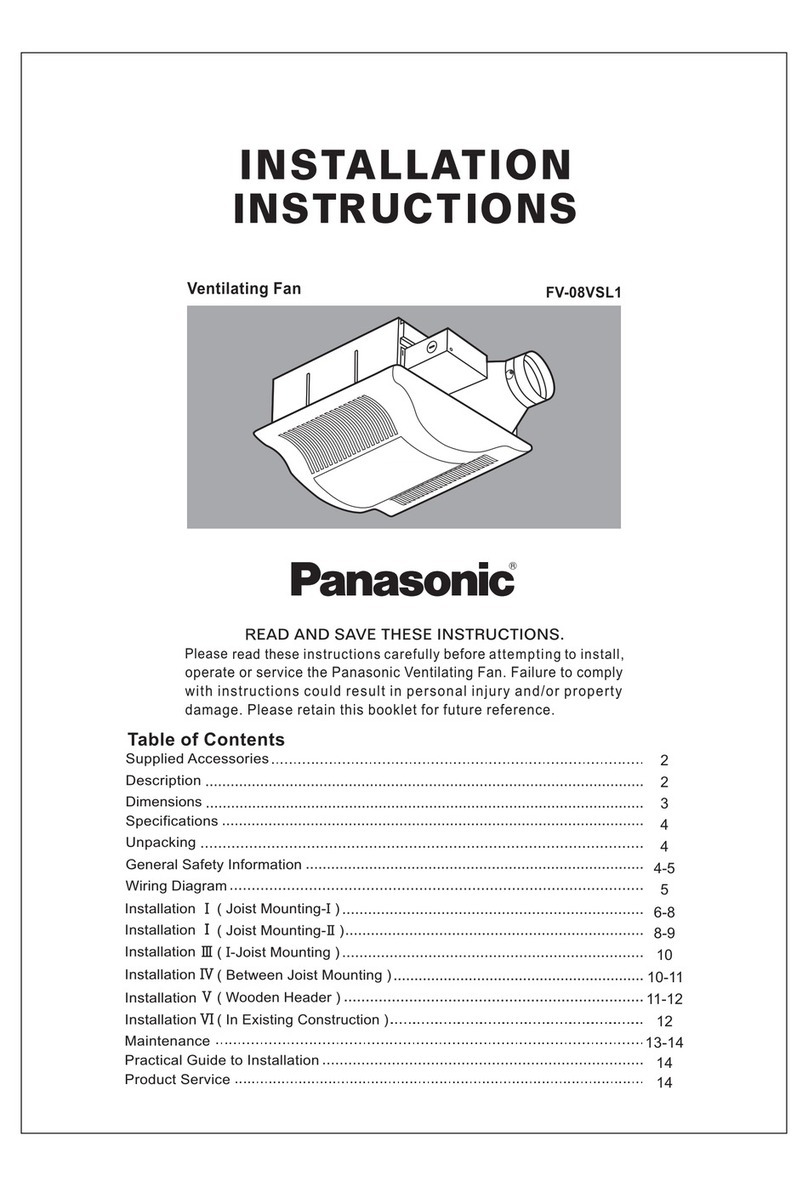
Panasonic
Panasonic Whisper Value-Lite FV-08VSL1 installation instructions
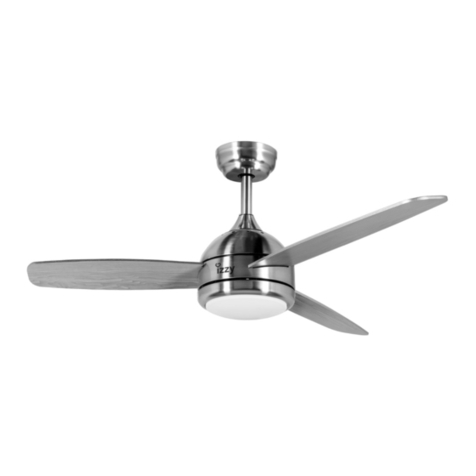
izzy
izzy IZ-9022 instruction manual
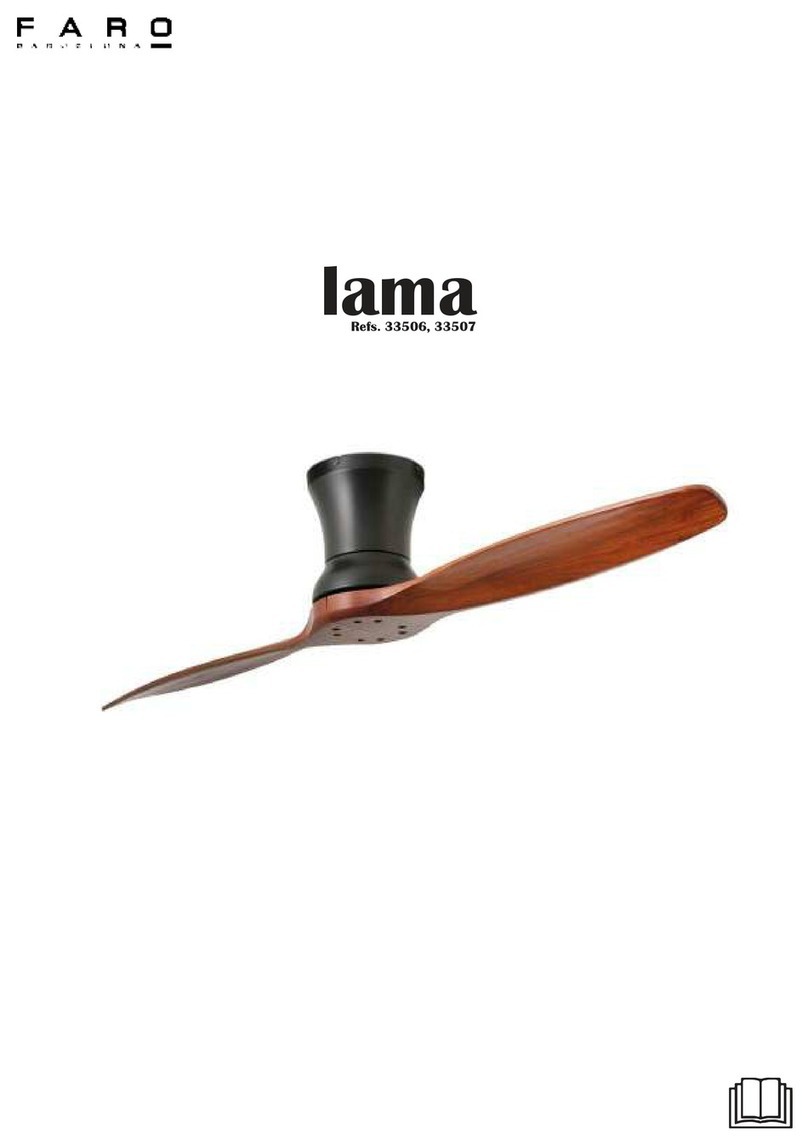
Faro
Faro lama 33506 manual

Home Decorators Collection
Home Decorators Collection TRUDEAU YG545-EB Use and care guide
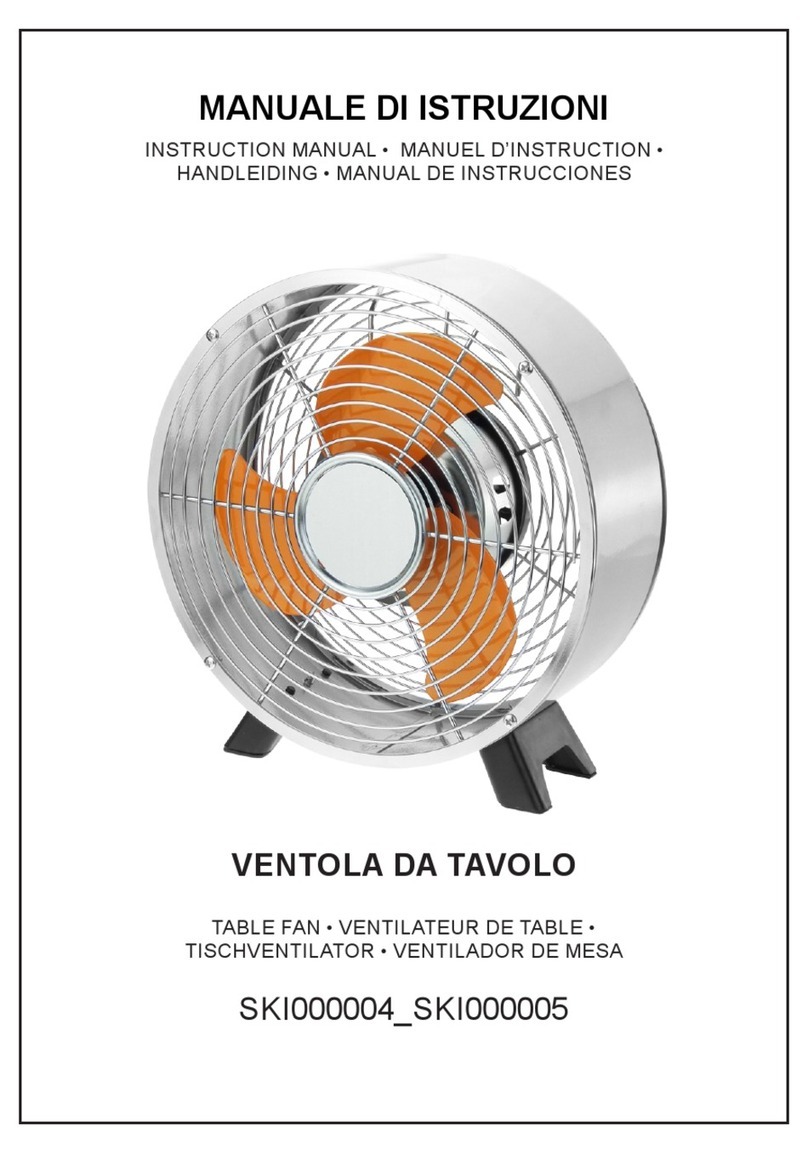
Kasanova
Kasanova SKI000004 instruction manual

EUROM
EUROM HVF14-2 Instruction leaflet

Hoval
Hoval HomeVent comfort FRT 251 operating instructions
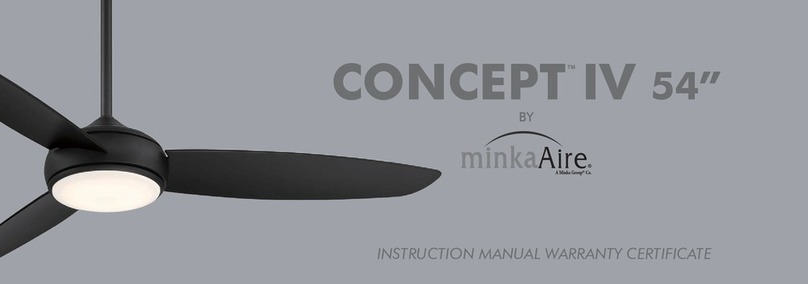
Minka Group
Minka Group minkaAire CONCEPT IV Instruction manual warranty certificate

Carrier
Carrier PF4MNB Series installation instructions
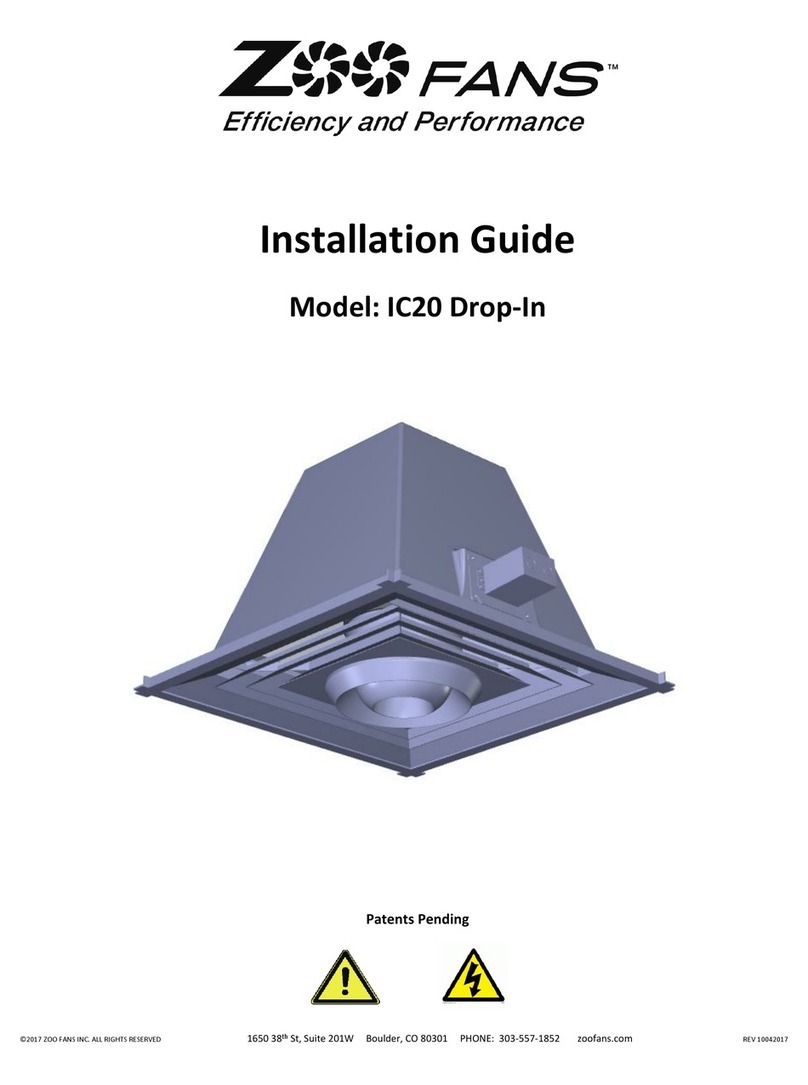
Zoo Fans
Zoo Fans IC20 Drop-In Installation guides

Innova
Innova 2.0 Installation, use and maintenance manual
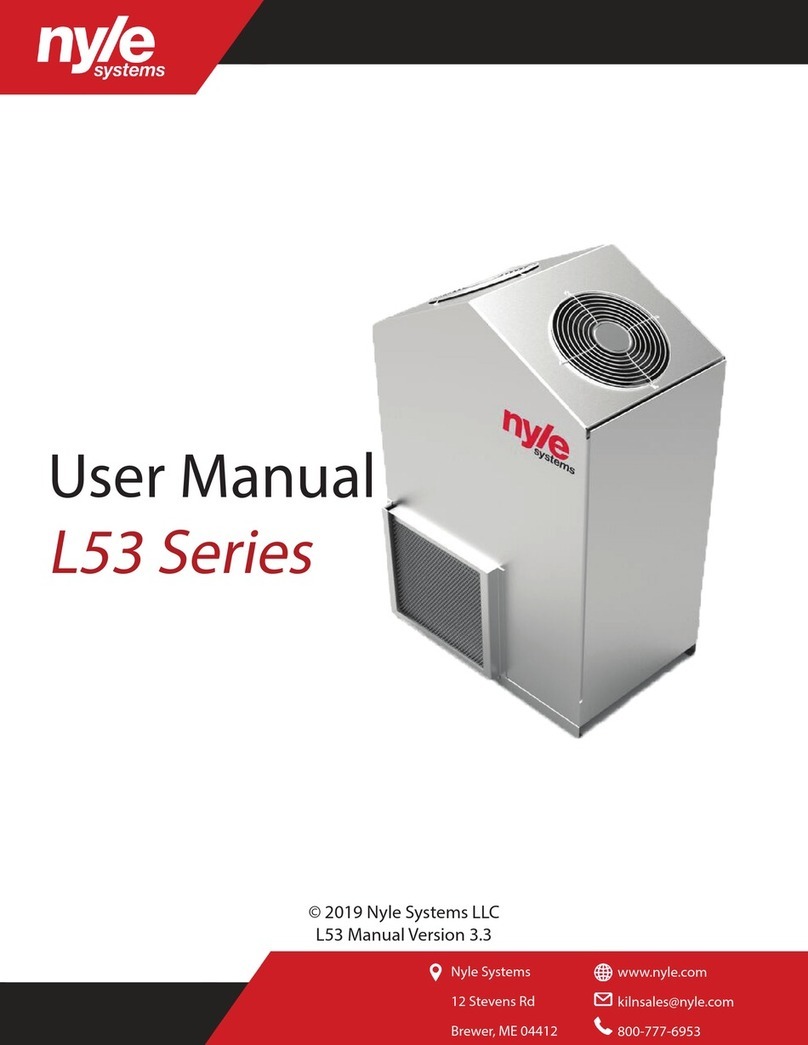
Nyle
Nyle L53 Series user manual







